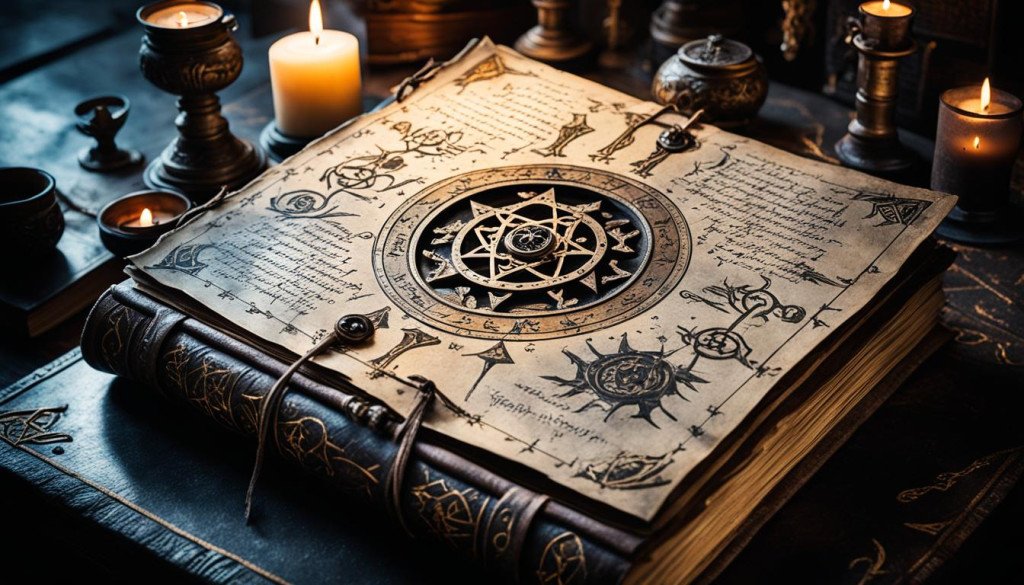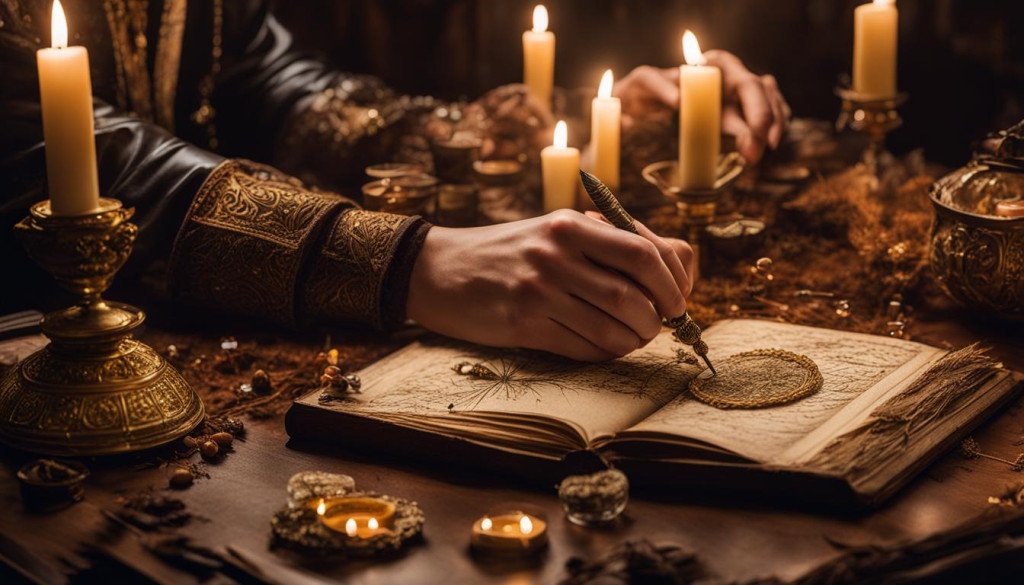The concept of a Grimoire—a storied book of spells—stands at the heart of this exploration, inviting the curious and the devout alike to uncover its secrets. Brimming with enchantments and magic spells, these enchanted volumes offer a window into a world where the mystical is tangible and potent.
Beyond mere fantasy, the Grimoire is steeped in historical reality, a compendium of esoteric wisdom that has evolved through the ages. From the incantations of shamans to the elaborate rituals of modern-day sorcerers, spellbooks have perpetuated the legacy of human interaction with the supernatural. This guide invites you to delve into the purpose and power of Grimoires and to understand their place in the cultural of witchcraft and sorcery.
Key Takeaways
- Discover the historical significance of Grimoires and their roots in ancient civilizations.
- Gain insight into the different enchantments and magic spells chronicled throughout time.
- Learn about the mystical practices of creating and using these venerable magic books.
- Unwrap the allure behind these tomes of occult knowledge and their evolution across cultures and eras.
- Understand how Grimoires serve as manuals of magical instruction and personal diaries reflecting a practitioner’s journey.
What is a Book of Spells (Grimoire) and Its Historical Significance

At the heart of any conversation about the mystical practices of yore, one is bound to hear mention of a spellbook known as a grimoire. Decoding the enigma of these books leads us into a labyrinth of occult knowledge, where each turn unveils a new aspect of the storied past these volumes carry within them.
A grimoire is a chronicle of mankind’s eternal quest to harness the ethereal powers that govern our world – through ancient rituals and secret lore.
The term ‘grimoire’ has etched itself into the collective imagination, signifying a treasure trove where all mystical practices are inscribed. These manuscripts were sought after by those who yearned to peek beyond the veil of reality, offering elaborate instructions for crafting amulets, foretelling the future, and invoking the supernatural.
The Origins of Grimoires
Digging into the dust-laden histories of grimoires takes us back to the ancient Middle East, where the seeds of today’s occult knowledge were first planted. Manuscripts such as ‘The Book of Abramelin’ have been pivotal to developing Western esoteric traditions. In these developing times, grimoires were dense with astrological charts, alchemical secrets, and the paraphernalia of necromancy – all deemed immensely potent and sometimes feared for the powers they could potentially unleash.
The Evolution of Magical Texts Over Centuries
As time unfurled its relentless passage, the knowledge enshrined in grimoires traversed continents, permeating various cultures. This journey was marked by transformation, and nowhere is this more evident than in medieval Europe. Here, amidst the crucible of the eras, grimoires started to mirror the prevailing religious and cultural zeitgeist, weaving together the threads of Christian symbols and older occult knowledge. The evolution of these texts reflects an intertwining narrative of belief systems and the universal human desire to understand the forces that shape our lives and destinies.
Types of Spellbooks and Their Varied Uses

Within the mystical world of witchcraft and sorcery, a book of spells (grimoire) is not merely a collection of enchantments. It is a repository of the practitioner’s power and wisdom. Varying dramatically in content and purpose, these spellbooks offer insights into the diverse practices and intentions that define the craft. From collections of herbal remedies to compendiums of high ceremonial magic, each grimoire is as unique as the sorcerer who wields it.
Let’s delve into the world of magical texts, where every spell, every magic, and every ritual holds a story whispering the secrets of ages past. Whether bound in leather or inscribed on parchment, these books continue to serve as conduits of arcane knowledge. Here, we explore some of the distinct types of spellbooks and their multifaceted uses:
- Herbal Grimoires: These focus on the magical properties of plants and how to harness them through potions and elixirs.
- Ceremonial Magic Books: Detailed instructions for summoning and communing with ethereal entities are the centerpieces of such tomes.
- Folk Magic Spellbooks: These books contain practical magic for everyday needs, such as securing love, warding off evil, and blessing new ventures.
- Personal Sorcerer’s Journals are Handwritten volumes chronicling an individual’s journey through the realms of magic and personal insights.
| Grimoire Type | Focus | Common Uses |
|---|---|---|
| Herbal Grimoires | Botanical Knowledge | Crafting of potions and herbal remedies |
| Ceremonial Magic Books | Spiritual Entities | Summoning rituals and complex ceremonies |
| Folk Magic Spellbooks | Day-to-day Magic | Simple charms for protection, prosperity, and healing |
| Personal Journals | Individual’s Magical Practice | Documenting personal magical experiences and spells |
Understanding the types and uses of these grimoires is just the beginning. As one delves deeper into the study of witchcraft and sorcery, this ancient knowledge’s true breadth and depth unfurl like a map to hidden treasures.
Understanding the Contents of a Grimoire

Delving into a grimoire reveals more than just magic spells and enchantments. They are reservoirs of accumulated wisdom, drawing from ancient rituals and complex incantations that form a codex of the mystical arts. Understanding the facets of these contents is essential for anyone interested in the grimoires’ powers.
The Structure of a Traditional Spellbook
The quintessential grimoire is a meticulous blend of lore and practice, establishing a rigid framework that guides the spellcaster from novice to adept. Initially setting the mystical scene, it elaborates on the fundamental theories of magic, imparting essential knowledge before exploring actual incantations. Proceeding forward, the practitioner is led through increasingly detailed magic spells, each accompanied by critical ritualistic aspects and reflective entries.
Common Spells and Enchantments Included
In the realm of a spellbook, one may encounter a spectrum of enchantments designed to summon various effects upon the world. These include spells aimed at procuring love, fostering prosperity, and casting protection shields. Furthermore, a grimoire may also offer vital insights on the preparation of magical incense, the charging of potent talismans, and the meticulous timing of rites by celestial events.
| Category of Spell | Purpose | Astrological Timing | Additional Components |
|---|---|---|---|
| Love Enchantments | To attract affection and bond relationships | Venus’s Day (Friday) | Rose petals, red candles |
| Prosperity Rituals | To increase wealth and opportunities | Jupiter’s Hour | Green candle, cinnamon sticks |
| Protection Incantations | To ward off negative influences | Day of Mars (Tuesday) | Black tourmaline, white sage |
| Healing Spells | To promote recovery and well-being | Sun’s Day (Sunday) | Clear quartz, eucalyptus leaves |
Creating Your Own Grimoire: Personalizing Occult Knowledge

Embarking on creating your book of spells (grimoire) is an extension of your mystical practices and a deeply personal journey. A grimoire is more than just a spellbook; it is a repository of your magical experiences and a reflection of your innermost self. Let’s delve into the initial steps in crafting a grimoire that resonates with your unique magical path.
Selecting Materials and Design for Your Spellbook
Selecting the right materials for your grimoire is both practical and metaphysical. Durability is critical, as this sacred tome will accompany you for many enchanted years. Whether you’re drawn to the traditional leather-bound aesthetic or prefer a more eco-friendly option, choosing a material that feels empowering and supportive of your practices is important. The design aspect is equally integral, as the aesthetics of your grimoire can inspire and enhance your spellcraft.
| Material | Pros | Cons | Suitability |
|---|---|---|---|
| Leather | Durable, classic feel | Not vegan-friendly | Ideal for traditional practitioners |
| Recycled Paper | Eco-friendly, unique texture | Maybe less durable | Great for eco-conscious witches |
| Handmade Paper | Personal touch, variety of styles | Can be expensive | Perfect for artistic souls |
| Cloth Hardcover | Customizable, textile variety | Can wear over time | Suitable for those who love crafting |
Recording Spells and Incantations
The act of inscribing spells and incantations breathes life into your grimoire. This is where your spellbook transitions from a mere object to a living record of your spiritual evolution. Each entry is a testament to your dedication to the craft and a step forward on your mystical journey.
In your grimoire, every spell, carefully noted herb, and personal reflection come together to form a tapestry of your magical identity. As you mark the pages, consider the words you write and the energy you imbue them. Your dedication and intent are just as critical as the physical ingredients of your spells.
- Consider using different colored inks to categorize and access various types of spells. easily
- Create a table of contents as you go to keep your grimoire organized
- Leave space after each entry for notes on results and reflections
Remember, there is no right or wrong way to create your spellbook; it is a personal artifact that grows and changes with you. The power of your grimoire lies in its ability to capture the heart of your mystical practices and spellwork.
Mystical Practices: How to Use a Book of Spells

The art of wielding magic spells is deeply rooted in the engagement with the earth’s energies and the cosmos. When you open a grimoire, you enter a millennia-old mystical practice and knowledge continuum. Employing this wisdom is not as simple as uttering incantations; it requires a dedicated mindset, attuned to the intent and vibrancy of ancient energies.
To commence this sacred journey, one must comprehend the immensity of the ancestral wisdom enshrined within these tomes. Delving into a book of spells is to navigate a labyrinth of ancient rituals, each step resonating with the echoes of the ancients.
Consider the following steps to align yourself with the mystical threads woven into your spellwork:
- Establish a quiet and contemplative space, free from the turbulence of modern life, where you can focus your mind and spirit exclusively on the task at hand.
- Prepare yourself through meditation to reconcile your inner frequency with the archaic currents that animate the spell’s essence.
- Pursue ritual purity, an age-old prerequisite that varies in form—from fasting to ablutions—but always aims to prime your physical vessel for the sacred work.
- Learn from the grimoire with humility, recognizing that its pages hold secrets passed down through generations of adept practitioners.
Commanding the mystical forces encapsulated in your grimoire is a transcendental experience that merges the practitioner’s intent with the boundless realms of magic. Use these ancient practices with respect for the past and a vision that binds together every incantation into the grand tapestry of the cosmos.
Protecting and Consecrating Your Grimoire

For practitioners of the mystical arts, safeguarding the integrity of a book of spells is as vital as the enchantments within its pages. A grimoire is the heartfelt chronicle of one’s witchcraft journey—a repository that demands protection from both physical harm and ethereal contamination. Below, we explore the sacred rituals to preserve the purity of your magical companion.
Energetic Cleansing Techniques
The essence of a grimoire can be clouded by energetic debris. It’s imperative to regularly cleanse your spellbook to keep its magical incense as effective as the day it was bound. Methods such as smudging with sage, allowing the soft glow of moonlight to bathe its pages, or briefly burying the book in a bed of natural salt empower the tome, stripping away the residues of past sorcery and preparing it for new enchantments.
Methods of Magical Protection for Your Spellbook
Warding off unwanted energies requires more than mere physical barriers. Invoking protective enchantments or creating talismans specifically for your grimoire are quintessential witchcraft practices. These measures shield your sorcery repository and ensure that every incantation and ritual remains untainted, potent, and pure. Let us delve deep into the arcane ways to consecrate and defend your cherished vessel of occult knowledge.
- Smudging with Sacred Herbs – Lighting magical incense and allowing the smoke to envelop the grimoire cleanses it energetically.
- Moonlight Bathing – Placing your spellbook under the luminous night sky during specific lunar phases imbues it with celestial purity.
- Encasement in Salt – A potent element in witchcraft, salt can draw out and neutralize negative energies that have latched onto your grimoire.
- Enchantment Invocation – Casting a spell of protection around your book forms a barrier against psychic intrusion and energy leeching.
- Talisman Creation—Crafting an amulet with safeguarding intentions can serve as a guardian for your grimoire, repelling baleful influences.
Through meticulous care and magical fortification, your grimoire will stand resilient amidst the ebb and flow of mystical forces. Whether by the smoke of herbs, the sanctity of earth and moon, or the deliberate crafting of protective charms, your book of spells will remain a formidable vessel of your witchcraft, steeped in sorcery and ready to assist in the weaving of enchantments for years to come.
Deciphering Ancient Rituals and Modern Methods

Understanding ancient rituals and their applications in modern spiritualism is more than an academic exercise—it’s a journey through time, bridging millennia of wisdom. Today’s seekers of the arcane can glean much from the dusty pages of a spellbook, discovering potent incantations that have stood the test of time. But beyond mere recitation, integrating these rites into contemporary practice requires a grasp of their symbolic language and an appreciation for the transcendent power of magical incense.
In an era that prioritizes evidence and practicality, the metaphysical practitioner is challenged to embody traditions that often seem archaic or esoteric. To facilitate this, we must view the old ways through a lens highlighting their relevance and adaptability to our current daily rituals.
- The language barrier: Translating ancient scripts not only linguistically but in a manner that resonates with current understandings.
- Material adaptation: Finding contemporary equivalents for ritual components that may no longer be accessible or acceptable.
- Philosophical evolution: Interpreting the underlying principles of rituals in the context of modern ethics and worldviews.
- Technological integration: Utilizing modern tools to enhance the practice of ancient rituals without diluting their essence.
While deciphering and adapting ancient rituals can be daunting, the rewards are equally profound. In reconnecting with the arcane, we honor our ancestors and their wisdom and reinvent the fabrics of our own spiritual identity.
Magical incense, once a means to sanctify space and invoke deities, today can be a tool for meditation and mindfulness, leading to a peaceful mind ripe for spells. Similarly, an ancient chant or incantation might find new life in personal affirmations or the melody of a modern spiritual song. In this way, the secrets of the past illuminate the path forward, proving that within every spellbook lies not just history but a map to the future of magical practice.
Navigating the Ethics of Witchcraft and Sorcery
The practice of magic reaches into the deep wells of intention and ethical responsibility. Delving into witchcraft and the usage of a spellbook carves out a path that is as much about the wielder’s values as it is about their skills in sorcery. How a practitioner aligns their inner purpose with the mystical energies at their command shapes the nature and effect of their enchantments. Acknowledging the profound influence of intention in magic, we must also thoroughly explore the moral facets of spellcasting, ensuring our foray into this arcane world is conducted with the utmost consideration for its far-reaching impacts.
The Importance of Intention in Magic
In sorcery, the energy directed by the caster’s will is the crucial factor determining the efficacy of the desired outcome. Intentions act as the guideposts that channel the potency of enchantments toward their ultimate goal. The clarity of purpose and the essence of the practitioner’s desire fuel the transformational power of magical practices. Whether one’s aim is to heal, protect, or open new pathways of understanding, it is the purity and focus of one’s intent that weaves the strongest spell.
Moral Considerations in Spellcasting
Engaging with the rich tapestry of witchcraft extends beyond personal gain or curiosity; it is enveloped in the web of ethical implications that each spell carries. Spellcasting, therefore, comes with the inherent duty to consider the ripples one creates in the universal pond. What effects will your enchantments have on others and the world at large? Weighing the consequences of invoking the powers encapsulated within ancient grimoires is a solemn act, underscoring the practitioner’s commitment to wield such knowledge with skill and wisdom. In essence, the practice of witchcraft is tightly interwoven with the fabric of moral responsibility, guarding the sanctity of the magical realm.
FAQ
What exactly is a Book of Spells (Grimoire)?
A Book of Spells, called a Grimoire, is a repository of occult knowledge, ancient rituals, and magic spells. These texts have historically served as manuals of magic, detailing mystical practices for summoning spirits, crafting amulets, and performing enchantments.
Can you discuss the historical significance of Grimoires?
Grimoires hold a significant place in history, particularly in the realm of the occult and witchcraft. Their origins can be traced back to the ancient Middle East, with texts like ‘The Book of Abramelin’ being pivotal in Western occultism. Over time, these magical texts have evolved to reflect the cultural and religious milieu in which they were transcribed, such as the incorporation of Christian elements in medieval Europe.
What are the different types of Spellbooks and their uses?
Spellbooks vary greatly, from widely recognized tomes such as ‘The Key of Solomon’ to personalized, hand-written books crafted by individual practitioners. They cater to various aspects of witchcraft and sorcery, like herbalism, ceremonial magic, or specific cultural folk practices. This diversity underscores the multitude of approaches within the craft.
What commonly found spells and enchantments are included in a Grimoire?
Inside a Grimoire, you’re likely to encounter a variety of spells dealing with love, prosperity, protection, and healing, among other things. These often include detailed instructions for rituals, creating magical incense, and charging talismans, typically aligned with astrological events for added efficacy.
How can one create their Book of Spells?
Creating your own Grimoire is a profoundly personal and spiritual endeavor. It involves selecting materials that resonate with you, whether for their aesthetic or energetic qualities, and a design that fits your practice. Inscribing your spells, rituals, and reflections turns a plain book into a dynamic record of your magical journey.
How should one use a Book of Spells in mystical practices?
Using a Grimoire entails more than just reading out spells; it demands an engagement with the mystical practices within. This may include meditative states, purification rituals, and a thorough understanding of the ancient rituals to align oneself with the magic’s energy for the spell to work.
How can you protect and consecrate a Grimoire?
Protecting a Grimoire involves energetic cleansing techniques like smudging with sage, utilizing magical incense, burying the book in salt, or placing it under the moonlight. To prevent unwanted energies from affecting its knowledge, one can cast protection enchantments or create amulets to serve as spiritual safeguards.
How can you reconcile ancient rituals with modern magical practices?
Ancient rituals can quite seamlessly integrate into modern practices. This requires a discerning approach to adapt time-honored traditions, allowing a contemporary practitioner to weave these into their own spiritual framework, ensuring the timeless arcana remain relevant today.
What are the ethical considerations when spellcasting using a Grimoire?
Ethical spellcasting emphasizes the importance of intention, which should be clear, focused, and harm-free. Casting spells responsibly means considering the wider impact of your actions on others and the world and conducting your magical work with an awareness of its potential ripple effects.





